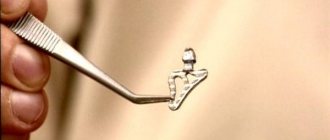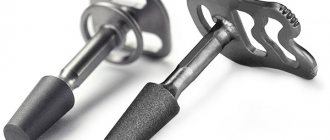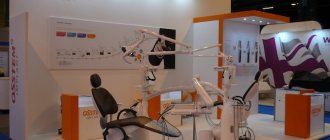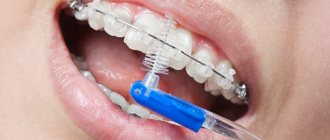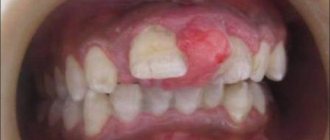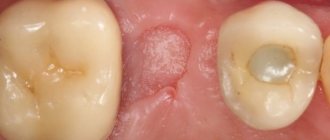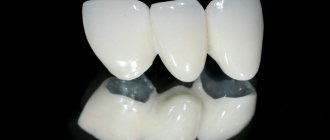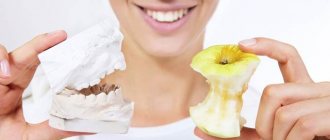Dental implantation is a serious operation, after which complications occur. Unpleasant consequences occur in 1−2% of cases and can be associated both with the incompetence of the specialist and with the patient’s failure to comply with preventive measures. Symptoms of dental implant rejection appear immediately after implantation or after some time. In order to identify the problem on time, it is important to regularly visit the dentist for an examination.
How does an implant normally take root?
After installation of the implant, a period of osseointegration with the jaw tissue begins, which is divided into three stages:
- Initial (3-4 weeks). Accompanied by the formation of spongy bone tissue around the implanted titanium rod. Until it is strong and has low density, chewing loads can negatively affect engraftment.
- Formation of mature bone (16-18 weeks). The spongy tissue is replaced with lamellar tissue, which completely fills the space between the implant and the areas of bone damaged during installation.
- Final (up to one and a half years). The artificial root finally fuses with the bone tissue. However, after 3-4 months on the lower jaw and 5-6 on the upper jaw, the bone acquires sufficient density. The difference in timing is due to the anatomical and physiological characteristics of bone tissue.
When can dental implant failure occur?
Implants implanted into the lower jaw bone take root in an average of two to four months. In the case of the upper jaw, the healing period increases to six months. The reason for this is greater strength and better blood supply to the bone tissue of the lower jaw. In addition, she experiences greater stress. At the same time, prosthetics of the upper jaw is also complicated by the proximity of the maxillary cavities.
The process of integration of the artificial root with the surrounding bone tissue begins immediately after its implantation into the jawbone. The time period required for complete engraftment depends on the condition of the bone tissue, the type of structure and the level of its quality.
The method of implantation does not have a significant effect on the duration of osseointegration. The duration of engraftment does not particularly depend on whether a temporary crown was installed on the implant immediately after its insertion into the bone, or only after its complete integration with the tissue.
The greatest risk of implant failure occurs in the first few days after implantation. That is, if any medical errors were made, or the patient’s existing health problems affected them, or the artificial root itself turned out to be of poor quality or incorrectly selected, then complications arise quite quickly.
However, even if no problems arise immediately after implantation, the patient should not become careless: the inflammatory process leading to rejection of the implanted tooth can develop even years after implantation.
Rejection is often preceded by peri-implantitis, an inflammatory process in the tissues of the jaw bone and gums surrounding the implanted tooth. If you do not take timely measures to treat inflammation, then gradual tissue destruction will occur, and the artificial root will lose its stability, and this is rejection.
Signs of rejection
Swelling, pain, fever and bleeding of the gums in the first 5-7 days after implant installation are normal phenomena that go away on their own. If symptoms persist after the specified period and increase, you should urgently consult a doctor.
The failure of the implant is indicated by:
- inflammation and swelling of the gums;
- bleeding;
- strong pain;
- body temperature 38ºС and above;
- discharge of pus and unpleasant odor;
- mobility or loss of the installed structure.
Sometimes rejection occurs asymptomatically or with one of the above symptoms. Regardless of what signs appear, patients should be attentive to their own well-being. If something bothers you, contact the clinic immediately .
Related articles:
- Implant service life
- Complications during implantation
- Best Dental Implants
Factors influencing survival rate
Dental implants are widely used in modern dentistry. They are systems, most often made of titanium, which are embedded in the bone tissue of the jaw.
Next, an abutment with a prosthesis is installed on the implant. If the outcome is favorable, the implant gradually takes root, that is, osseointegration occurs.
The rate of osseointegration depends on the location of the implants. On average, their engraftment rate is:
- 4 months for the lower jaw;
- 6 months for the upper jaw.
The differences in timing are explained by the fact that the bone tissue of the upper and lower jaws has slightly different densities.
The bone tissue of the upper jaw is more porous, so it takes longer for osseointegration. The bone tissue of the lower jaw has a denser structure, so the implant takes root in it faster.
The process of implantation of an artificial tooth root takes place in several stages:
- Formation of trabecular bone. It is a fragile spongy formation consisting of bone plates.
Trabecular bone forms within the first two weeks after implantation of the artificial root. During this period, it can be easily damaged, so prostheses are not installed on the implant immediately. - Formation of mature bone tissue. Trabecular bone tissue is transformed into denser lamellar tissue.
It forms over about 5 months. Gradually, it fills the gap between the artificial root and the jaw bone. - Strengthening bone tissue. This process is completed after one and a half years. After six months, the bone is considered strong enough to accept dentures.
The likelihood of developing peri-implantitis depends on how successful the osseointegration process is.
Peri-implantitis is an inflammatory process that develops in the bone tissue in the area where the artificial root is implanted. It is one of the reasons why implant rejection occurs.
The survival rate of an artificial root depends on various factors:
- Individual factors. Osseointegration is more successful and faster in young patients, as well as in people who do not have chronic diseases or bad habits.
- The quality of the artificial root. Implants that are made from high-quality titanium alloy using modern technologies have a better chance of successful survival.
- Implantation technique. When using the classical method, the implant takes root within about six months. When using the more modern basal method, engraftment occurs faster.
- Dentist skill. If the operation to install an artificial root is performed by a qualified specialist, the likelihood of complications is minimized.
- Compliance with the dentist's recommendations. The speed and quality of osseointegration depends on scrupulous adherence to the advice of a specialist in hygiene, nutrition and lifestyle.
The survival rate of implants depends both on the quality of the installation procedure and on the patient himself, in particular, his lifestyle.
What is the purpose of installing a gum former on an implant, and how long is it left in place?
Come here if you are interested in indications for open sinus lift surgery.
At this address you will find objective reviews about laser dental implantation.
Causes
The implant may not take root for the following reasons:
- Peri-implantitis is an inflammation of infectious tissue around the implanted rod, leading to progressive loss of the jaw bone. It develops immediately after installation, several months and even years later. The main cause of the disease is smoking. Tobacco smoke constricts blood vessels and leads to poor circulation in the gums.
- Allergy to the construction material - titanium is biocompatible with jaw structures, but in rare cases it can cause an allergic reaction. Such situations arise if the doctor uses low-quality systems that contain impurities. In exceptional cases, when a patient is found to be allergic to titanium, zirconium oxide implants are used.
- Health problems in the patient - diabetes, immune diseases, oncology and hypertension increase the likelihood of rejection to 100%.
- Unsuitable bone structure - with a porous bone structure, even with sufficient volume, the implant will not hold. To prevent this, the bone is additionally strengthened with special material.
- Violation of the osseointegration process occurs due to the installation of cheap systems, the components of which, when in contact with the jaw structures, provoke the growth of scar tissue rather than bone. As a result, fibrosis develops and the structure falls out.
In our Center, the listed points are excluded. We work only with reliable, time-tested implants from Nobel Biocare (Switzerland). Before the procedure, we carefully examine the patient to identify the characteristics of the dentofacial apparatus and possible contraindications. We perform implantation after eliminating risks and provide a guarantee for treatment.
How to prevent rejection
In order to reduce the likelihood of rejection, it is necessary to pay attention to the following aspects of preventing this problem:
- First of all, carefully select the clinic where the implantation procedure will be performed. To do this, it would be useful to read customer reviews and make sure that the specialists are highly qualified.
- An important stage of implantation is the preliminary treatment of the patient’s ailments.
- It is necessary to pay considerable attention to strengthening the gums.
- Follow all the recommendations of your doctor, which will maximize the life of the implant, which will protect against the possibility of rejection.
In order to reduce the likelihood of implant rejection, you must:
- Carry out daily oral care.
- The possibility that the patient is allergic to the raw materials used should be completely excluded. In case of allergic reactions, the product is replaced with a similar one, but made of a different material.
- In some cases, dentists recommend that their patients massage their gums to stimulate blood circulation.
Daily oral care
Now you know not only about the alarming symptoms that may indicate implant rejection, but also about the causes of such a negative phenomenon, and therefore you can prevent its occurrence.
Patient's review of upper jaw dental implantation using the all-on-6 protocol
How it happens at different times
Express rejection
Occurs with a coarse porous bone structure. This feature makes it impossible to create a reliable support for the titanium root - the bone is not able to provide the implant with the necessary fastening and nutrition, and cannot provide sufficient tension to hold the implant. Problems in this case can be avoided with the help of growth stimulants (morphogenetic proteins), which are attached to the neck of the implant and activate the growth and compaction of the surrounding bone mass.
Also among the common causes of early rejection:
- premature loading of the implant with a crown at the time of engraftment during express implantation;
- infection of the jaw tissue when installing an implant immediately after tooth extraction with inflammation at the root.
Deferred period
Usually, if rejection does not occur a month after implantation, then osseointegration took place without complications. However, there are cases of later rejection when crowns were installed on the implant and everything looks fine. Among the reasons:
- Prosthetic errors occur when the angular chewing load on the titanium root is increased. It manifests itself as pain when chewing and redness of the gums.
- Inflammation of the tissues in the implant area due to a bacterial process that develops due to the accumulation of food debris between the teeth. It may be asymptomatic at first, but over time it is accompanied by bleeding gums - it looks inflamed, swollen, like periodontal disease. After a year or two, this condition leads to the structure falling out.
What can a doctor do if the implant does not take root?
The implantologist will take an x-ray and analyze the situation. If the implant is immobile and the inflammation has not affected the bone tissue, treatment may be limited to conservative measures. The doctor will remove the crown from the implant, then clean its surface mechanically and treat it with antiseptics.
If the jaw bone is affected, surgery will be required. During the operation, the gum is incised and all softened bone tissue is removed. A bone graft is placed in the area of the resulting defect. The implant is usually removed (especially if it was installed incorrectly). Although sometimes the dentist can replace only its head - the abutment. If necessary, surgery is also performed to restore the aesthetics of the gums.
As a rule, there are no contraindications to re-implantation in patients with implant rejection. But after treatment you will have to wait until the tissues heal and local immunity is restored. It is important that the doctor is able to understand exactly why the dental implant did not take root, so that the situation does not repeat itself in the future.
If the implant fails for the second or third time, this indicates that:
- the implantologist is incompetent,
- the patient has low bone density or has hidden diseases that prevent implant healing.
How often does it occur - what is the percentage of rejection?
Implant failure is an extremely rare occurrence and should not be a concern for patients. According to statistics, it occurs in 1-2% of cases. When installing brands popular on the world market (Nobel Biocare, Astra Tech, Straumann), the figure is even lower, amounting to 0.2-0.5%. These manufacturing companies carefully examine each case of rejection and eliminate negative factors. Professional clinics using original products and installation protocols guarantee a survival rate of 99%.
Levin Dmitry Valerievich
Chief physician, Ph.D.
Questions and answers
3 years ago I had implants placed on my lower jaw and the remaining teeth were removed.
And in March, all the implants were removed. The result is changes in bone tissue and flat gums. Is it possible to install a flexible prosthesis there? I have a removable denture on top. 3 years ago I had implants placed on my lower jaw with the removal of the remaining teeth. And in March, all the implants were removed. The result is changes in bone tissue and flat gums. Is it possible to install a flexible prosthesis there? On top of my head there is a removable denture
Hello! Prosthetics with soft dentures in such cases is possible, but a preliminary examination of the oral cavity is necessary. Come visit us for a free consultation. Based on the results of the examination, our orthopedists will offer you the best options for dental prosthetics in your case. You can make an appointment by calling + 7 (495) 789-42-02. Sincerely, Patient Support Center SIMPLADENT++8 800 333-53-41
I would like to know how safe it is to carry out implantation and prosthetics at once and whether installing a prosthesis will harm the healing of the implants?
Good afternoon. I have four teeth in a row on my upper jaw on the left side that need to be removed, including two front incisors. The doctor recommends immediate implantation and prosthetics. I would like to know how safe it is and whether installing a prosthesis will harm the healing of the implants. Of course, you don’t want to walk around with a hole in your mouth, but you also don’t want to make things worse.
Hello. Modern implantation systems used in implantation protocols with the possibility of immediate dentures are equipped with special aggressive threads. Implants are screwed into the bone, providing maximum tissue compression. That is, the bone becomes stronger and firmly holds the artificial root in the hole.
The adaptation prosthesis, which is installed on implanted implants, has a metal base that works on the principle of a beam - the implants and prosthesis are a single system, which ensures high primary stability and immobility in the jaw bone. Artificial teeth fixed on a metal beam are made of metal-plastic.
This is a lightweight material that is strong enough to fully participate in the chewing process, but does not overload the implants. Only with this material is it possible to correct the bite at the time of engraftment of the implants. The prosthesis is permanently fixed and should be worn until the osseointegration process is completed - on average this takes about 6-12 months. It is then replaced with a permanent structure made from more durable and aesthetic materials. More detailed information can be obtained at a free consultation with a specialist in one of our clinics.
SIMPLADENT specialists will answer all questions by phone: + 800 333-53-41 Other questions
What does the doctor do if symptoms appear?
If signs of implant failure appear, the patient should contact the clinic. The measures taken are determined by the doctor based on an examination of the installed implant and X-ray data.
The tactics for eliminating symptoms are individual in each clinical case:
- After installing the titanium root, bad breath appeared. The cap screw is unscrewed from the titanium rod, cleaned and put in place.
- Inflammation affects periodontal tissues without going beyond them . The gum is opened, the affected area is cleaned and disinfected. Antibiotics are prescribed.
- The source of infection spreads to the bone . The degree of bone destruction is determined. After stopping the inflammatory process and removing necrotic tissue, bone grafting is performed (directed bone regeneration using protective membranes).
- Severe tissue damage accompanied by bone recession was diagnosed. A decision is made to remove the structure.
What to do if inflammation begins under the implant?
If alarming symptoms of incipient inflammation appear in the area of the installed implant (there is a smell coming from under the implant, pain appears, redness of the gums, swelling, etc.), the only correct solution is to immediately consult a doctor. The implantologist will conduct a visual inspection of the condition of the installed implant, perform an X-ray examination, and, if necessary, open the gums and help cleanse the wound of pus.
If problems began during the period of implantation of the structure, then sometimes the cause of the unpleasant sensations (for example, a putrid odor from the implant) is easily solved by temporarily unscrewing the implant plug and cleaning its outer surfaces.
But if there are obvious signs of peri-implantitis, in most cases removal of the installed implant is indicated, and this must be done as soon as possible. Otherwise, advanced inflammation can lead to the spread of infection throughout the body, which is fraught with very serious consequences, even threatening the patient’s life.
In addition, the longer the inflammation in the implant area is observed, the more the bone tissue around it is destroyed, and the more problems there may be in case of re-implantation.
Is it possible to re-implant after implant failure?
In most clinical cases, re-installation of the implant is possible, but only after eliminating the infection and restoring damaged tissue. If there are no contraindications, implantation is carried out 1-2 months after removal of the unaccustomed structure. If the jaw bone remains unloaded longer, the atrophic process begins .
The final decision is made depending on the reason for rejection. If the cause is a chronic disease or the body’s reaction to a foreign body, repeated attempts will not yield results. It is better to choose another method of restoring missing teeth. If the patient does not want to quit smoking, there is no point in repeating the procedure.
Survival rates
We can talk about successful osseointegration 2 years after installation of the structure, if it is used without complications. The survival period is divided into three stages:
- short-term: after installation and before prosthetics, treatment is not yet completed;
- medium-term: prosthetics are completed and the structure is used for 1-2 years;
- long-term: continued use of the structure.
There is a risk of complications at each of these stages.
Short term. If implant rejection occurs, it means that osseointegration has not even begun. This is a very rare complication that occurs in less than 0.01% of cases. Lack of osseointegration is associated with:
- Using low-quality tools. If the implant bed is prepared without cooling or with insufficiently sharp cutters, the bone tissue overheats, and its necrosis and fibrous degeneration begin. The implant is installed in fibrous tissue and osseointegration does not begin;
- Incorrectly installed structure. If there are positioning errors, it becomes surrounded by soft tissue, does not contact the jaw bone, and the process of osseointegration cannot begin;
- Sepsis. It may occur if implantation is performed immediately after tooth extraction, in an area near inflamed tissues or a source of purulent lesion;
- Treatment errors. Along with implantation, the patient can undergo bite correction, endodontic or periodontal treatment. The actions of doctors in this case must be coordinated. Most often, implantation completes the course of treatment and is performed after all other dental health problems have been resolved;
- Presence of contraindications. The patient may not be aware that he has diseases that prevent osseointegration. The doctor’s task is to organize high-quality diagnostics and collect information about the patient’s health status before starting treatment;
- Use of low-quality materials and designs. If the titanium alloy is not processed well, fibrous tissue may form, which will interfere with osseointegration;
- Failure of the patient to comply with hygiene rules and doctor’s instructions.
Do you have questions about implantation?
We will call you back within 30 seconds
or call +7 (495) 373-10-25
By clicking the “Submit” button, you automatically agree to the processing of your personal data and accept the terms of the User Agreement.
Medium term. Osseointegration began and was completed, but eventually rejection occurred. Its risk is highest in the first two years after implantation. Rejection occurs due to peri-implantitis (the most common and best studied complication).
Causes:
- poor-quality connection of the abutment to the implant;
- errors in implant installation, its positioning, formation of peri-implant pockets that are difficult to clean, development of the inflammatory process;
- too high load on the prosthesis. It can occur if the crown installed during prosthetics is slightly higher than the rest of the teeth in the row. Another reason is bruxism;
- improper care. The patient does not follow the doctor’s recommendations, does not provide high-quality oral hygiene, and does not undergo regular examinations and professional teeth cleaning. Smoking can also increase the risk of rejection. Because of it, vasoconstriction occurs, a deficiency of nutrition and oxygen occurs, and tissues begin to atrophy.
The risk of peri-implantitis in the medium term is not affected by the size (diameter or length) of the implants.
Long term. If no rejection has occurred in the first two years after implantation, further use of the structure depends on the quality of dental care. Oral hygiene must be of high quality, you need to regularly visit the dentist for examinations, it is advisable to give up bad habits.
What to do to prevent the situation
- The risks are minimal when dental restoration surgery is performed by an experienced doctor in a well-equipped clinic. Large Centers do not skimp on equipment and staff training. When choosing a dentist, you can rely on reviews from patients who have already undergone treatment there.
- Go through a full examination, tell the doctor about all your health problems, without hiding anything.
- When choosing implants, you should not save money; in this situation, the price is proportional to the quality. Popular brands have more guarantees and fewer risks.
- Follow the doctor's recommendations in the postoperative period, including giving up bad habits.
Make an appointment with an implantologist
What do we do to avoid unpleasant consequences?
We install Nobel Biocare implants
Produced by the Swiss company of the same name. The survival rate is 99.3% - the highest rate in dental implantology. They solve any edentulous problems, even against the background of acute jaw bone deficiency. They have their own markings to protect against counterfeiting. Equipped with a patented micro-structured porous surface TI-Unite, which accelerates the osseointegration of the rod with the jaw tissue and activates regeneration processes. Nobel implants have a lifetime warranty.
We exclude contraindications
Before implantation, it is important to exclude the patient from diseases that could negatively affect the implant’s healing. Among them: blood diseases, uncompensated diabetes mellitus, pathologies of the immune system, oncology. To identify health problems, the patient is prescribed blood tests, computed tomography, and, if necessary, consultations with other specialists, such as a cardiologist, endocrinologist, phlebologist, or ENT specialist. In our Center, during the period of implantological treatment, correction of chronic diseases is carried out, and a full-time ENT doctor also conducts consultations.
We develop a treatment plan
Planning is an important step in preparing for surgery. Provides for the selection of implant models, their location in the jaw, taking into account the anatomical features of the dentofacial apparatus and the condition of the bone. Our Center performs computer modeling to ensure surgical accuracy, reduce the likelihood of complications and predict treatment results.
We maintain sterility
This is the main condition for successful implantation. During the procedure, the doctor uses only clean instruments and uses antiseptics to disinfect the oral cavity. Each implant is packaged in a sterile box, which is opened immediately before installation. The risk of infection is zero.
We act according to installation protocols
Our doctors were trained in the most modern high-tech training centers. They are fluent in advanced treatment methods and successfully apply them in practice. We use only original components and installation protocols that speed up engraftment.
We take action in a timely manner
The rehabilitation period is constantly monitored by a doctor. We invite patients for examinations, give recommendations on caring for the installed structure, nutrition, and lifestyle. The doctor is on call around the clock if the patient has any questions about treatment.
What should the patient do?
- Eliminate solid foods from the diet so as not to overload the implant;
- take prescribed medications;
- avoid overheating and hypothermia;
- stop smoking - smokers have a significantly higher risk of implant rejection;
- maintain oral hygiene - brush your teeth 2-3 times a day, rinse your mouth with antiseptic solutions, use floss or irrigator to remove food debris from the interdental spaces;
- visit the clinic as scheduled.
Causes of Dental Implant Rejection
The causes of rejection often arise due to doctor error, due to improper procedure. Sometimes rejections occur due to the choice of a low-quality or counterfeit implant. The patient must follow all the doctor’s instructions and know the rules of behavior during the recovery period, although rejection is also possible due to the patient’s health condition.
The reasons that cause symptoms of dental implant rejection are the same in almost all cases:
Medical error or unprofessionalism.
Immediately after the operation, during the engraftment period, the implant may be rejected precisely because of a doctor’s error. So, an implantologist can make the following mistakes during the work process:
- Incorrect choice and selection of implant design. In this case, it will not be able to attach to the bone.
- Non-sterile work area, instruments or oral area.
- Overheating of tissues during preparation of the hole for the implant.
- Incorrect implant placement.
- Lack of knowledge of the patient’s health status, which may have contraindications to implantation.
It is quite difficult for a doctor to operate on a patient due to the insufficient amount of bone tissue to secure the implant (if it is atrophied) and acute inflammatory processes.
In the case of acute inflammation of the jaw tissue, rejection is possible, and re-implantation is not always possible due to severe bone destruction.
Choosing a low-quality implant.
Modern doctors and large clinics cooperate with companies that supply quality products directly from the manufacturer. If the clinic is small, the situation is worse.
The quality of the implant plays a very important role, and the more expensive the system, the better the materials and the more modern technologies were used to create it. The engraftment process, as well as the risk of rejection, are associated with the material from which the product is made and the characteristics of its surface. It must be titanium that is biocompatible with our body.
Patient violations of instructions during the recovery period.
Rejection is possible at any time - both during healing and after a couple of years. Even if the doctor did everything correctly, but the patient does not properly care for the oral cavity, this can lead to bad consequences.
Dos and Don'ts:
- In the first days after surgery, overheating and hypothermia of the body are strictly prohibited. This applies to trips to swimming pools, baths, saunas, etc.
- Do not overload the implant during the healing period.
- You should not hide health problems from your doctor, otherwise it can lead to dire consequences. You need to tell the doctor everything.
- You should not smoke, drink or perform other activities harmful to the body.
- If your doctor has prescribed medications against implant rejection, they should be taken to minimize the risk of developing peri-implantitis and speed up healing.
- Careful oral care is necessary - brush your teeth in the morning and evening and remove leftover food.
In practice, implants installed in smokers are rejected more often than in non-smokers.
Deterioration of health.
This reason often appears several years after the installation of implants. If the implants did not fail during the first two years, the treatment was successful. Although there are cases when such a problem occurs many years after the operation. This happens rarely and is mainly due to injury, exacerbation or development of diseases such as AIDS, diabetes, oncology, etc.
What affects implant healing?
Implants are an artificial tooth root that is screwed into the bony part of the jaw like a screw. They are made from titanium. The body perceives it as native and does not reject it. The bone actively penetrates into all the unevenness of the coating and holds it like cement.
Implants do not take root if they are not installed correctly initially. There are cheap pins - subperiosteal or subperiosteal, which are a flat openwork design. They are not implanted into the bone, but under the gum.
In the pursuit of speed and finances, the interests of patients are often not taken into account. The survival rate of such implants is much lower than that of screw implants. Their rejection may occur after a few years as a result of bone tissue atrophy.
DETAILS: Dental prosthetics on implants. Postoperative period
Atrophy can be avoided by replanting it or using the basal implantation method. In this case, implants of a special design are used. But rejection of the basal pins can also occur at any stage of engraftment.
Implantation is the most predictable method of treatment not only in dentistry, but also in general medicine. Using high-quality material and instruments, the success rate of the operation is 98–99%. There are cases when the implant did not take root, but rejection did not occur. The problem is solved by reinstalling.
